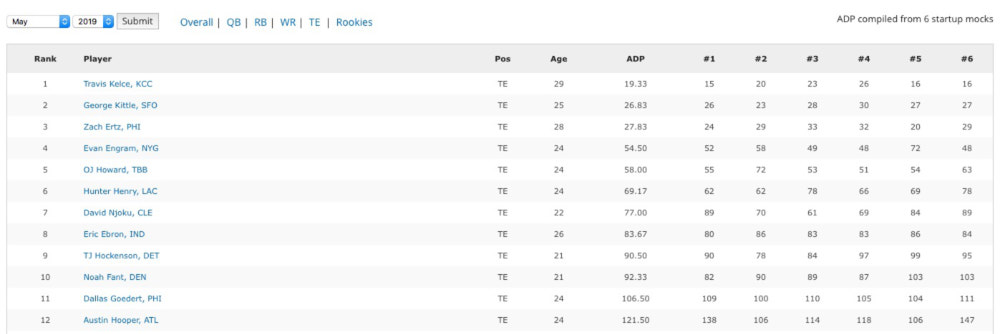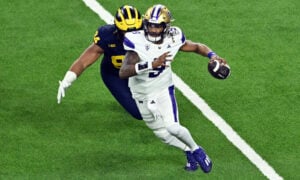Eric Ebron: The Dynasty Tight End You Need to Buy
So far this off-season, I’ve detailed two players that you should be acquiring in your dynasty leagues: Tyler Boyd and Marlon Mack. Today, we are taking the same approach and applying it to the tight end position.
Tight end is such a tricky position to evaluate. Everyone likes to grab their sleeper player hoping that someday they will become one of those coveted top-three tight ends. I’ve started taking a different approach, focusing my efforts on buying players who have recently broken out.
One of the wonderful things about this approach is that it takes the guess work out the evaluation process. Just simply buy productive players. There is a caveat to this though. As a dynasty player, I seek value. Sure, you could pony up to acquire Travis Kelce, Zach Ertz, or George Kittle, but that may leave you vulnerable at a different position considering the price it takes to acquire them.
Instead, I want a tight end who produced well that comes at a cheaper cost. I also want this player to be a value, meaning that he is ranked higher in my model compared to the overall dynasty community. So, I set up some search parameters, plugged in the most recent DLF ADP, and one name stood out above the rest: Eric Ebron, my model’s number five tight end.
College Profile
As we did with previous players, I want to start by taking a look at Ebron’s college profile. In terms of how my model ranks players, their college profile doesn’t matter after their fourth season in the NFL. So currently, Ebron’s collegiate resume does not matter in regards to how the model values him. I still think it’s helpful to take a look at what kind of prospect he was.
Here are the metrics that I have found to matter most when evaluating collegiate tight ends:
- Best College Dominator
- Ideally, we want to see a dominator above 26.2%
- Speed Score
- A score above 106.5 checks this box
- Burst Score
- We want tight ends who can accelerate quickly, ideally with a score above 120
- Draft Capital
- Like with receivers and running backs, we want tight ends to be drafted Day One or Two
So how did Eric Ebron do?
College Dominator – 18.8% (miss)
Speed Score – 111.1 (check)
Burst Score – 116.0 (miss)
Draft Capital – Round 1 (check)
Honestly, it’s kind of a mixed bag when it comes to his collegiate profile. Like I said earlier though, tight end is a tricky position to evaluate. Ebron definitely has positive attributes in his profile. Besides, the thresholds listed above are for the most elite tight end prospects such as Travis Kelce, Vernon Davis, Tyler Eifert, and Noah Fant. In my model, Ebron falls into a category of prospect that I’ve called Upside Tight Ends and includes player such as Ertz, Greg Olsen, and Jimmy Graham. Clearly, success can still be had with this kind of profile. Here’s some further proof:
| Stat | Eric Ebron |
|
| Height | 6’4” |
6’6”
|
| Weight | 250 |
265
|
| Dominator | 18.8% |
19.1%
|
| Speed Score | 111.1 |
108.1
|
| Burst Score | 116 |
118.1
|
| Draft Capital | Round 1 | Round 2 |
Now it’s obviously lofty to compare someone to Rob Gronkowski, but it goes to show that missing some boxes for a tight end is not a death sentence. It’s a testament to how difficult it is to evaluate the position. What we can take away, though, is that Ebron has a profile that indicates potential.
2018 Season
Let’s turn our attention to how the Colt’s tight end did last season. I’ve been hearing a lot about how we all need to sell Ebron because his touchdown rate was unsustainable. While this may be true, it’s better to look at how he performed in the stats that most predict future success for tight ends.
- PPR Points Per Game – 13.5 (#4)
- aDOT – 9.4 (#12)
- Yards Per Game – 46.9 (#9)
- RACR – 0.72 (#53)
- Receptions Per Game – 4.1 (#8)
- Targets Per Game – 6.9 (#6)
Putting these all together, Eric Ebron comes out as the number six tight end in terms of his Predictive Score. Another player who scored slightly better than him, but is receiving a lot more hype, is OJ Howard. Let’s take a look:
| Stat | Eric Ebron |
OJ Howard
|
| PPR Points Per Game | 13.5 |
11.8
|
| aDOT | 9.4 |
12.4
|
| Yards Per Game | 46.9 |
56.5
|
| RACR | 0.72 |
0.96
|
| Receptions Per Game | 4.1 |
3.4
|
| Targets Per Game | 6.9 |
4.8
|
What stands out between this two are the fact that Ebron is getting more opportunity and Howard is more productive. Eric Ebron is not the most efficient tight end in the NFL by any means, but he does get plenty of opportunity in the prolific Colt’s offense and that results in fantasy points.
Additional Proofs
Ebron did well in 2018, but is that sign of good things to come or is it just a fluke? I want to compare his past breakout season to the breakout season of another tight end: Eifert in 2015.
| Stat | Eric Ebron (2018) |
Tyler Eifert (2015)
|
| PPR Points Per Game | 13.5 |
14.7
|
| aDOT | 9.4 |
7.6
|
| Yards Per Game | 46.9 |
47.3
|
| RACR | 0.72 |
1.10
|
| Receptions Per Game | 4.1 |
4
|
| Targets Per Game | 6.9 | 5.7 |
There’s no debate that Eifert is both very talented and very unlucky. What looked like a promising career was derailed by continuous fluke injuries. Really the only difference between these two seasons is that in 2015 Eifert operated closer to the line of scrimmage which can also explain why he was more efficient (RACR).
Last year, Mike Tagliere of FantasyPros, wrote an article breaking down when tight ends tend to start declining. Nestled in that article is an observation that you should not expect elite production from tight ends before the age of 25. Remember all those years when Ebron was considered a bust in Detroit? Guess what? All of those seasons occurred before he turned 25. 2018 was his age 25 season and he broke out all over the place. Just another positive signal.
So, what does PFF have to say?
Ebron was PFF’s highest graded tight end in the red zone

He also just so happens to be on a team that produces the most tight end fantasy points.

Images from Pro Football Focus.
Here are some PFF articles about Eric Ebron:
A breakdown of his upward trajectory
He is the NFL’s best red zone TE
Conclusion
To summarize, Eric Ebron had a decent college resume that was similar to Gronk’s, was number six in Predictive Score, number five overall according to my model, performed similar to OJ Howard, brokeout like Tyler Eifert, broke out at age 25 which is right on track, was the best red zone tight end in the NFL, and plays on the team that led the league in tight end fantasy points.
I understand the hesitation because of his likely touchdown regression, but he is sending out every positive signal we could want that his future is bright. The best part is the value. He is currently being drafted as the TE8.
Now my model has him at five, which doesn’t seem like that much of a value, however, tight end value plummets drastically. According to the DLF Trade Analyzer, George Kittle is worth almost 3 times as much as Ebron.
Sure, Kittle got you more points, but I will not be surprised if the difference between the two is markedly smaller in 2019. Buy less expensive production; buy Eric Ebron.
- Top Ten Overrated Dynasty Players - January 31, 2020
- Dynasty Injury Impact: Week 14 - December 11, 2019
- Dynasty Injury Impact: Week 11 - November 21, 2019




































































